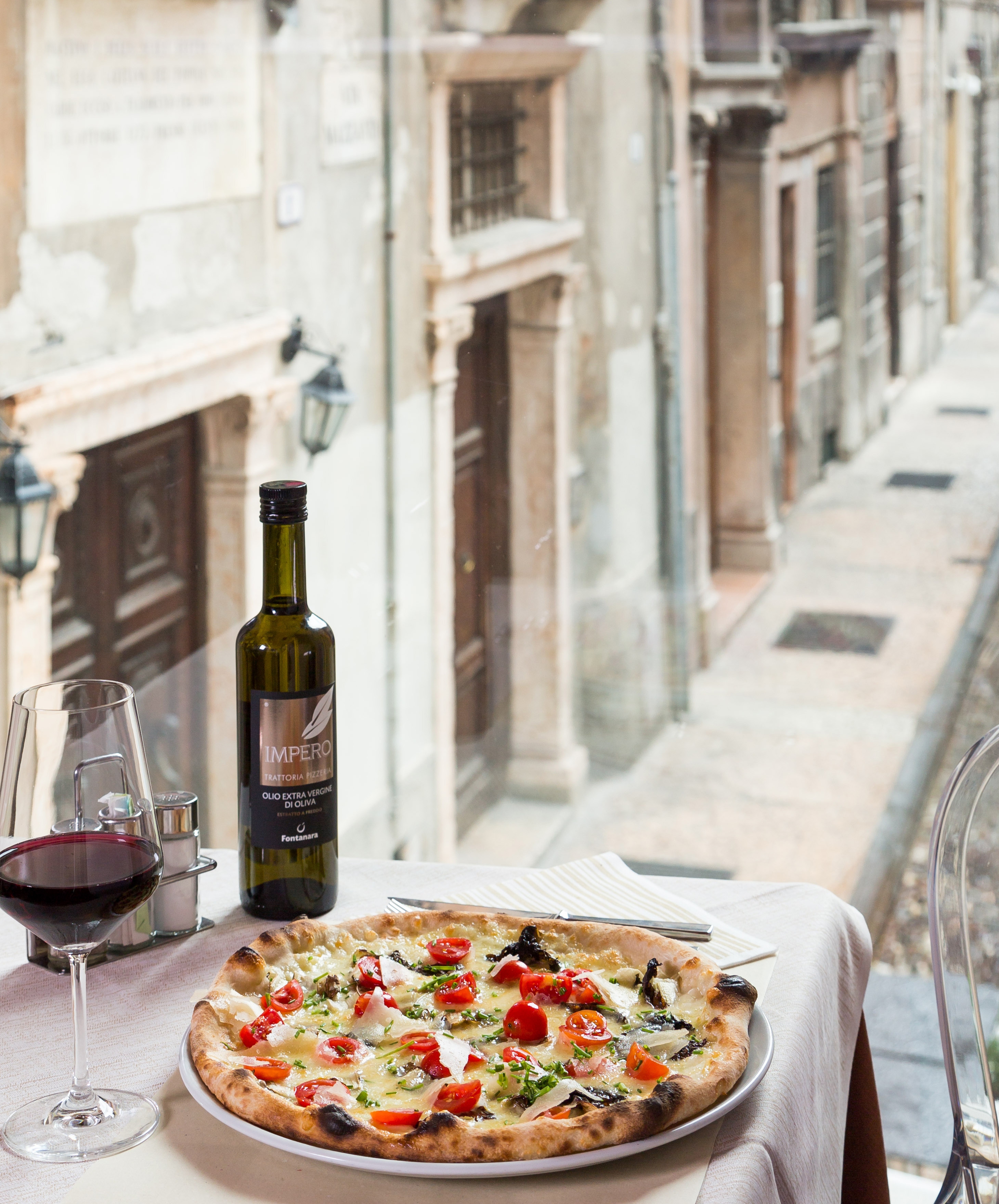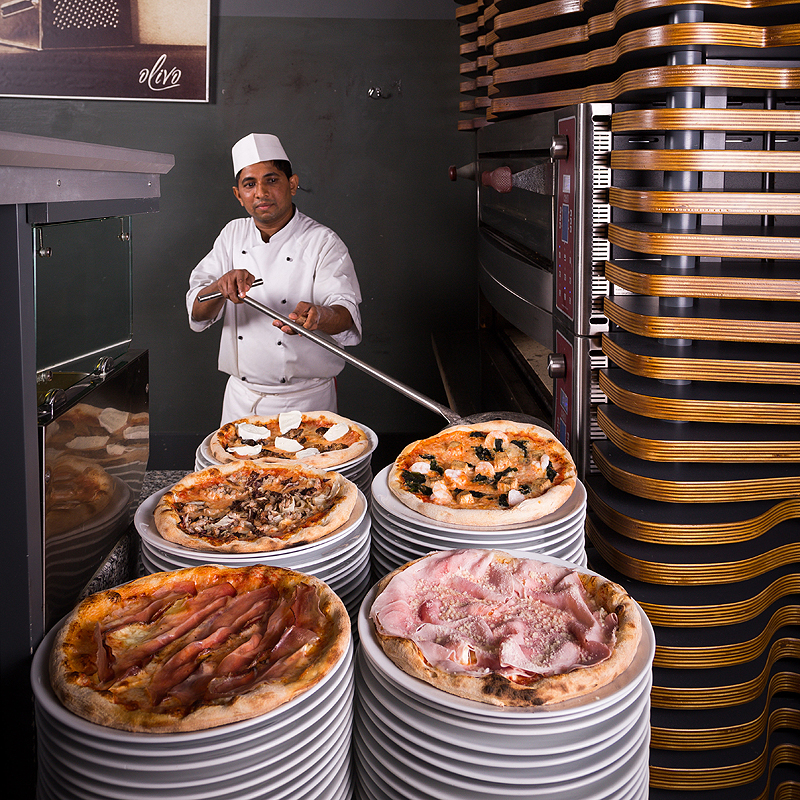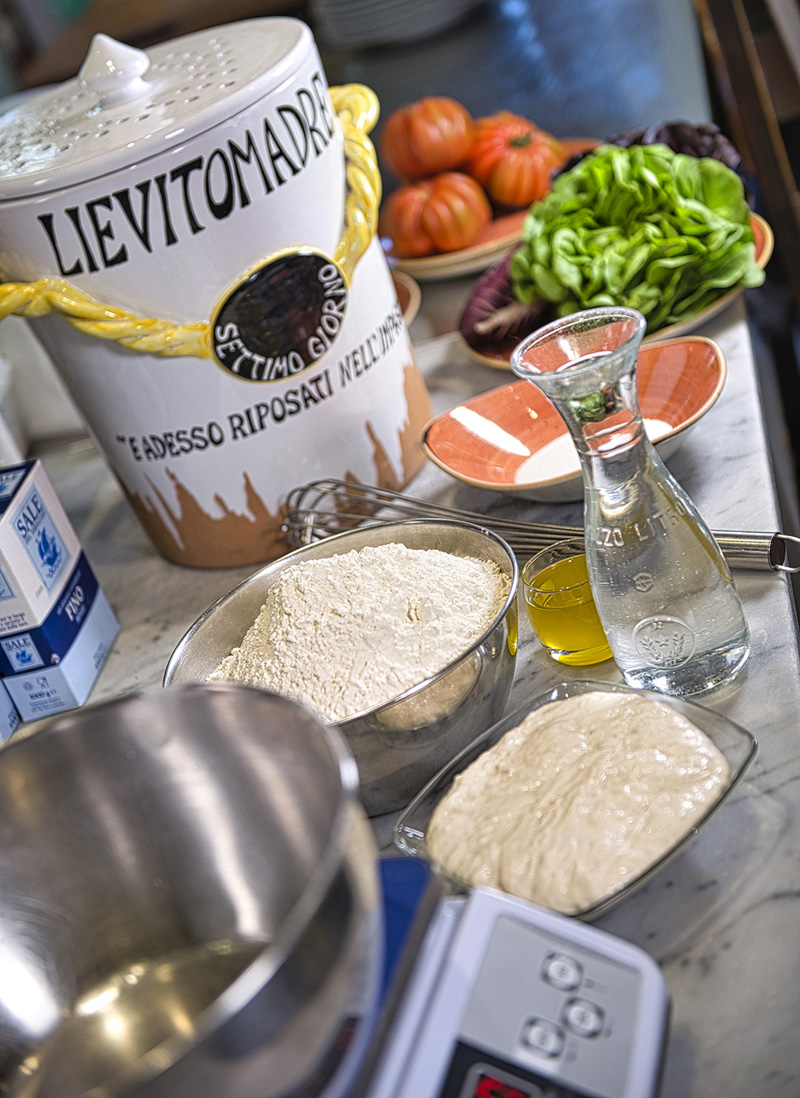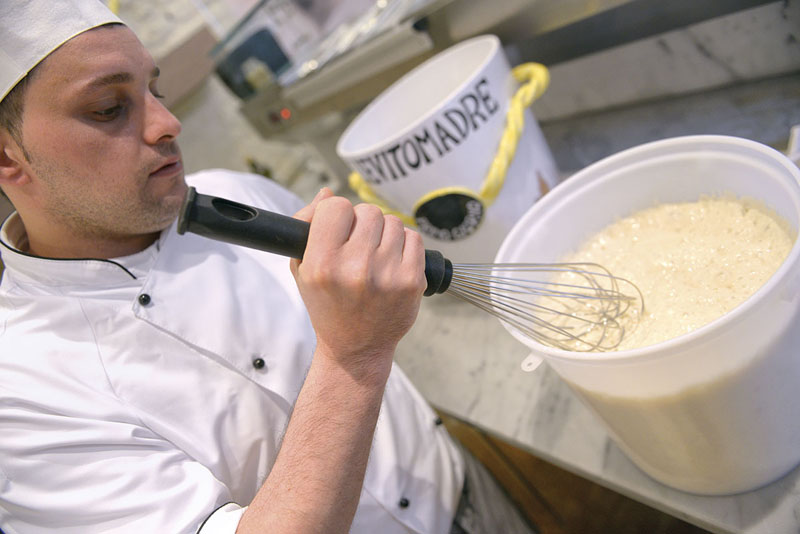La pizza
La pizza: a heap of genius and necessity
Pizza represents a fundamental part of the Italian historical and gastronomic identity. While the rest of the world recognises Italianness in pizza, Italians recognise themselves in it: it is a symbol of belonging. The origins of pizza date back to ancient times and are linked to the world of baking: this link allows us to trace in the various traditions of bread a fil rouge that connects Italy to the world.
The history of pizza, as we know it, began in Naples: there, necessity was made a virtue. As we know, hunger stimulates the intellect and so it happened in the Neapolitan city: thanks to the hands and the genius of its people, PIZZA was born. Perhaps it was the most sustainable and democratic answer to the need to feed oneself.
There are, in fact, few foods that can jointly satisfy the needs of taste and those of well-being at an affordable cost for everyone. It is 'a perfect example of democratic gastronomy, of social and even educational food'.

Origins of the name “Pizza”
The origin of the word 'pizza' is the subject of numerous arguments, although it is agreed that at the origin of the medieval Latin, then Neapolitan, and finally Italian word there are words imported into Italy by the Goths and the Lombards. After the Romans, the Lombards made their historical contribution to the pizza through a precise term bizzo-pizzo, from the German bizzen, meaning 'bite'.
This word was used by the Germanic rulers to refer to the flatbread. The history of pizza can be traced through the terms that have been used to identify it over the centuries.
From bite to morsel, from piece of bread to the word 'focaccia': it is a logical path that linguists call a 'metonymic translation process'. The term pizza first appears before the year 1000: in 997, in the Codex cajetanus of Gaeta, the word 'piza' is used to indicate a focaccia.

The Seventeeth Century

In the south of Italy, the wheat flour flatbread mixed with garlic and seasoned with lard and coarse salt continues to be a great success; the substitution of lard with olive oil and the addition of cheese and herbs date back to this period. At the dawn of the 17th century, a basil-scented recipe made its appearance, pizza 'alla Mastunicola'. There are no precise descriptions of pizza, but it is almost certain that the term established in Naples.
In the South, the term pizza is associated with a focaccia, flatbread, topped with whatever was available. We are still far away from real pizza: these schiacciate were nothing more than oven proofs for bread. From these 'oven proofs' derives the typically southern custom of selling pizzas baked in a baking tray. This is a 'gastronomic legacy' of tradition, a form of historical memory.
The 18th Century
Around the 18th century, Neapolitan pizza began to distinguish itself not only for its shape and toppings, but also for the emergence of an autonomous, innovative, and specific character. It is not precisely known when the Neapolitan pizza was invented; however, it is certainly to be understood not only as an evolution, but also as a specialisation of the handling of the dough (known, in similar forms, for centuries) as well as the baking.

Starting in the 18th century, pizza became a 'masterpiece of poor gastronomy'; its rise in Neapolitan alleys dates back to this period, until it became a symbol of the Belpaese. The art of the Pizzaioli, however, is very old; according to some historians, it derives from the preparation of mensae, i.e., baked wheat flatbreads, used in ancient times to lay food on top.
- The expression 'Let's go for a pizza'.
It is in the preparation of pizza that is enshrined the ultimate purpose of this food: the exchange of emotions and the ability to create socialising dynamics. In the rituality of preparation is concealed the deepest respect for the consumer: the pizza maker never works with his back to the customers, but in front of them. The art of Neapolitan pizza makers 'is the expression of a material and immaterial culture that unites'.
This expression finds a concrete and tangible implication in the habit of eating pizza and in the vocabulary describing this act, increasingly akin to a ritual: in the common laguage, in fact, it is customary to say 'let's go get a pizza' and not 'let's go eat a pizza'. In going getting a pizza is contained the deepest sense of that two-way relationship that is established between the pizza maker and the consumer: the pizza recipe includes a good dose of conviviality, because pizza is the result of a co-production process.
- Pizza marries tomato
Margherita and Marinara, the pizzas par excellence, are relatively recent: they are the daughters of the marriage between pizza (understood in its most rustic form) and tomato, which arrived from distant lands. The tomato arrived in Europe from Peru at the end of the 16th century.
It took two hundred years for the tomato to find its place in the Mediterranean gastronomy. In the beginning, it was considered an ornamental plant and it is interesting to note that by the end of the 19th century, the tomato was not considered edible in the United States.
George Washington Carver wrote a text to convince the Americans to introduce tomatoes into their diet: 'How to grow the tomato and 115 ways to prepare it for the table'. Just as important was the spread of pizza in the US thanks to the many Italian workers who emigrated overseas to seek their fortune.

- The 19th century
We do not know the name of the first pizza maker, nor the date on which the first ever pizza (as we know it) was made. However, it is known that throughout the 19th century pizzerias were always called 'le botteghe del pizzajuolo' (pizza makers' shops): it was only towards the end of the 19th century that the word 'pizzeria' appeared. The 19th century was the golden age for pizza, pizza makers, and pizzerias: pizza became completely and definitively established, more and more pizza makers specialised, and pizzerias became increasingly popular.
The birth of pizza and its cultural role are closely linked to the overcrowding that characterised Naples for four centuries. The rich variety of street food finds its raison d'être in the demographic increase that occurred in Naples. Indeed, pizza is the queen of street food: quick to cook, satisfying, cheap, and made with few ingredients.
- Raffaele Esposito invented the Margherita: between history and legend
It is said that on 21 May 1889, King Umberto I and Queen Margherita of Savoy travelled to Naples and stayed at the Royal Palace of Capodimonte. A pizza maker named Raffaele Esposito was called to court. Esposito travelled to the palace with his wife Maria Giovanna Brandi.
There, he cooked three pizzas that he then served to the queen: one with oil, cheese, and basil (a revisited version of the 'Mastunicola', the most famous pizza of the time), a pizza with 'cecenielli', and another with tomato and mozzarella to which his wife added basil. The queen particularly liked the latter for its taste, but especially for the colours that reminded her of the Italian flag. Intrigued, she asked its name and Esposito replied: 'Margherita, in your honour'.
- Why was pizza born in Naples?

It was not until the early 20th century that Neapolitan pizza became the pizza par excellence. According to traditional sources, Neapolitan pizza was born around the first half of the 18th century in one of the many taverns scattered around the city. At the time, within these places of popular gastronomy, was being experimented a new taste and a new 'guise for the centuries-old focaccia'.
Why was it born in Naples? In Naples, at the time, the factors that contributed to the spread of the product were concentrated: the natural environment, the social situation, the demographic pressure, poverty, and the city's history. Pizza was born where several popular, social, and cultural forces worked in a synergetic and latent manner.
- Natural environment
The climate and environment undoubtedly contributed to the birth and the development of pizza in Naples. There, the soil is naturally fertile and at the time offered all the products necessary for pizza to develop: tomatoes, although coming from South America, had been present in Naples since the 1500s and had found their habitat there; mozzarella was produced on the Monti Lattari of the Sorrento Peninsula; sugna, or pork fat, was widespread in Naples because it was common to raise pigs there; oil came from the Sorrento Peninsula; and, finally, valuable ingredients such as oregano, garlic, and basil were found there.
There were also the products of the sea: anchovies, cecenielli (newborn anchovies), clams, mussels, and shellfish. These ingredients had a common characteristic that was decisive for the spread of pizza: they were cheap and often considered 'poor'.
- Socio-economic environment

In 1503, the Kingdom of Naples came under the rule of the Spanish Crown. This event coincided with the introduction of a new political figure, the viceroy, and with a profound social transformation: most of the feudal lords moved to the capital to closely control the work of the viceroy; the feudal lords brought their subordinate staff with them and a mass of peasants followed them.
There was, therefore, a displacement of a large number of poor people from the countryside to the city. The reason was political: in the capital the distribution of bread at a controlled price or free of charge was ensured by royal order.
Between the beginning and the end of the 16th century, the Neapolitan population grew from 100,000 to 350,000: Naples became one of the most populous cities in Europe. The success of pizza is to be found in this great migration from the countryside to the city of poor and - above all - hungry people.
Pizza beyond the Neapolitan borders
The spread of pizza outside the Neapolitan borders took place slowly from the early 20th century. The spread of pizzerias corresponded with the revaluation of pizza: the latter lost its connotation as a poor food and became linked to the concept of leisure, especially in the evening.
In the inter-war period, the habit of eating out was not so widespread: pizza was cooked at home or taken wrapped in tea clothes. In this period, pizza took on a different role from the one it had played until then: it was no longer the food of the workers, the mid-day meal-breaker.
This new way of eating pizza corresponded with the 'birth' of the lunch break for office workers, while bricklayers brought lunch from home. With the second post-war period, more and more places offered the possibility of lunch or dinner: pizzerias multiplied in many cities.
- Pizza overseas
Before pizza spread to northern Italy, it had already spread overseas. The historical events that formed the backdrop to this event are contained in the following expression 'great migration'.
The origin of the spread of pizza overseas is to be found in this migratory phenomenon: people, their habits, rituals, and recipes migrated: pizza became an antidote against homesickness. The first pizzeria opened its doors in New York in 1895.

Within a few decades, pasta and pizza became the most popular foods in the United States. At the time, pizza makers were Italians, then they became oriundi, and finally Americans became pizza makers. The situation changed dramatically with the end of the war: pizza began to travel with the Italians who moved away or began to be discovered by tourists who came to visit the Belpaese.
- Pizza comes to the North
The second expansion, on the other hand, occurred after the Second World War: in this period, pizza trespassed and reached the North. The spread of pizza came, for the second time, thanks to a migratory flow: with the industrial boom in the triangle of Milan, Turin, and Genoa, thousands of people moved from the South to the North.
Again, cooking became a way to exorcise the detachment from their homeland; they migrated with their food and wine baggage and spread it by making less foreign a reality that did not yet belong to them. They began to make pizzas for the villagers and later for the locals.

In this period, which began in the 1960s, there was a proliferation of pizzerias: from Trentino to Veneto, from Tuscany to Emilia, all the way to Umbria. With 'the time the density was reversed', so that today there are more pizzerias in the North than in the South.
- Pizza in Verona
1962 was the year in which the first pizza was served in Verona. A record for two pizzerias in Verona: the 'Alla Costa' pizzeria and the 'Grottina' pizzeria. They gave Verona and the people of Verona the opportunity to get to know and experience the fantastic world of pizza. It was the beginning of a new gastronomic and cultural story.
The Cortelletti family took off the Alla Costa in 1968 from the Frigo family: long-standing pastry chefs and the first pizza makers in Verona. Pizza became successful and spread in this area of the North-East mainly thanks to these two realities. Giuliano Cortelletti, as a former hotelier, became 'the ambassador of pizza, as he saw in this dish a pivot around which social life could revolve'.
The 'Alla Costa' pizzeria changed location in 2005 moving to Piazza Bra, just a glance away from the Arena, becoming 'La Costa in Bra'.
The social role of pizzerias in Verona
Opening a pizzeria, in an area lacking the tradition of pizza, meant making a profound impact on consumer habits. Pizzerias brought not only a wave of novelty, but also a real revolution: it was accessible, non-exclusive, good, and decent.

For the first time cheapness was not synonymous with mediocrity of food and coarseness of ambience. Pizzerias therefore became spaces of socialisation and escape for young people: they represented a way out of the prying eyes of parents. Pizzerias were halfway between the inn/tavern and the restaurant: they became the places for couples.
It can therefore be said that the pizzeria socially became the place that accompanied the emancipation of an entire generation.
During the same period, 'carshop services' exploded in the USA: this way of enjoying food was able to combine the freedom of young people with the need for privacy.
- Pizza for Cortelletti
The Cortelletti family sees in the pizza the great themes of our times: 'globalisation, the tension between research and tradition, the challenges of sustainability, the promise of wellness of the industrialisation, and the aspiration for equality of opportunities and democratic participation'.
Consequently, making a pizza means giving life to an act of culture, an affirmation of oneself and one's philosophy.

- The yeast revolution
Yeast is one of the main subjects in the food and wine history written by the Cortelletti family. At the centre of this innovative drive is the desire to make pizza a food for everyone, no one excluded: inclusiveness is the driving force. This revolution stems from a profound awareness: the sourdough is a living being and as such is full of changes and surprises.
Working with sourdough 'brings with it two fundamental lessons: respect the freedom of others' lives and accept with good grace everything that does not depend on us'. The sourdough of Altro Impero restaurant was born on 15 March 2015, while the gluten-free sourdough was created at La Costa in Bra on 31 January 2016.
The gluten-free sourdough represents the realisation of the inclusion project that forms the basis of the gastronomic history of this family.

- The sourdough of Altro Impero Pizza & Natura
The sourdough of Altro Impero Pizza & Natura was born on 10 March 2015. A cold-pressed Zevio apple puree provided the first sugars that were necessary for the natural ripening. Since then, this precious ingredient has been stored away from the light in special ceramic jars of Grottaglie, one for each day of the week. These jars have been specially made for the restaurant and can be seen on the shelves inside it.

Sourdough requires low-temperature and prolonged cooking. For this reason, a state-of-the-art electric oven is used. It is this electric oven that allows to enhance the long natural leavening process and to make a pizza that is slightly smaller in size, but with raised and fragrant edges.
The pizza chef of Altro Impero refreshes the sourdough every day and lets the dough rest for at least 24 hours before using it to prepare the pizza.

- The sourdough of La Costa in Bra
At La Costa in Bra you can eat gluten-free pizza in its best artisanal form. It is prepared with a completely gluten-free sourdough, which was born thanks to the dedication of La Costa pizza makers on 31 January 2016.
The fresh dough is a mix of rice, corn and almond flour, and gluten-free sourdough that is already active and daily refreshed.
The long natural leavening process of at least 24 hours makes it light and digestible.
La Costa's gluten-free sourdough is also lactose-free. Like coeliac disease, the intolerance to this type of sugar is becoming increasingly common, so we wanted to make our pizza dough suitable also for the people suffering from this problem.
